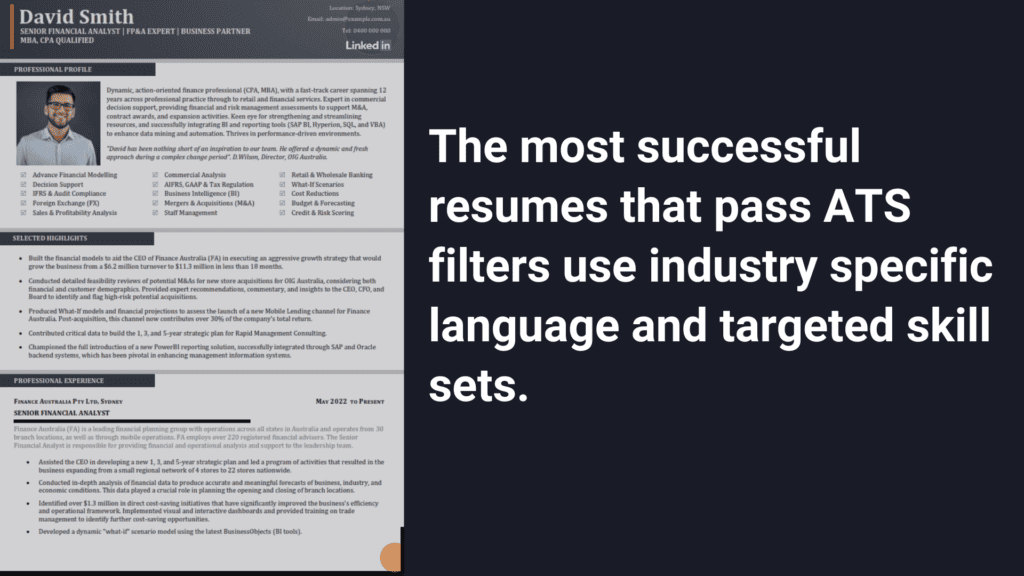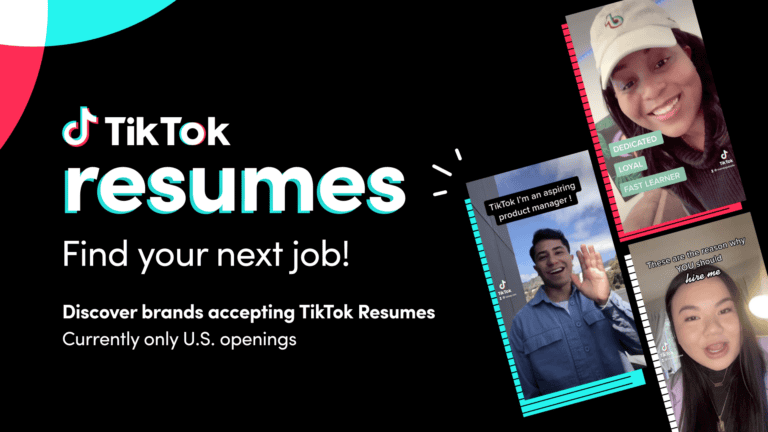To beat applicant tracking software, it’s important that you use key word rich content, optimise your Resume/CV, use industry standard titles and headings, implement skills sections, and avoid AI content.
The Changing Pace of Recruitment Software.
In the fast-paced world of recruitment and talent acquisition, Applicant Tracking Systems (ATS) plays a pivotal role in streamlining processes and improving efficiency for recruiters and employers alike.
In the following article, I have put together a guide to assist jobseekers with a better understanding of how Applicant Tracking Systems or ATS works from a recruiters perspective, and then delve into some strategic approaches for jobseekers on the strategies to optimise the application and how to beat applicant tracking software.
What does Applicant Tracking System (ATS) Do?
In essence, an Applicant Tracking System is a software tool that automates and simplifies the recruitment process. The main purpose of this software is to automate the entire recruitment pipeline, starting from publishing job ads to sourcing candidates, tracking interaction, and then managing the onboarding process (and everything in between).
The Key functions of an ATS include:
Job Posting and Distribution: ATS makes it possible for recruiters to craft and publish job ads on different platforms, including company sites as well as job boards.
Application Management: With its centralised database, ATS organises and stores candidate applications for easy access to this information.
Automated Candidate Screening: Recruiters can add specific filters and the ATS will search through applications in accordance with such requirements. Did you know? Seek.com.au has it’s own in-built ATS which you’ll need to rank high on.
Collaboration and Communication: ATS relevant functionality may include access to collaboration tools for hiring team members and simplified messaging with candidates.
Interview Scheduling: Many ATS solutions provide features for scheduling interviews in order to ensure a smooth and coherent interview process.
Database Management: The ATS maintains an information on candidates base which is accessible to authorized users.
Analytics and Reporting: ATS gives organisations valuable information about their recruitment metrics that make them shape up their hiring strategies.
Did you know?
Many job seekers assume that ATS is primarily used for candidate screening. That is incorrect. It is important to understand that while the candidate screening tool (i.e. ranking/scoring) is an option, the primary function of ATS is as an HR/recruitment management tool.
What companies in Australia use Applicant Tracking Systems (ATS)?
It is estimated that over 70% of companies in Australia use an applicant tracking system (ATS) of sorts, whether it be an in-house or off-the-shelf purchase through to leveraging the ATS of large job boards.
1. Major Industry Players:
Industry giants like BHP, CBA, CSL, Westpac, Woolworths, AGL etc leverage advanced ATS solutions to manage their extensive hiring needs. As do the major job boards such as SEEK. COM.AU. The scalability and comprehensive features of these systems align with the complex requirements of large enterprises.
2. Recruitment Agencies:
Firms specialising in recruitment benefit significantly from ATS, efficiently managing vast volumes of candidate data. The efficiency gained allows these agencies to match qualified candidates with suitable job opportunities more effectively.
3. Small and Medium-sized Enterprises (SMEs)
Even smaller businesses now recognise the advantages of ATS. The accessibility and organisation offered by ATS level the playing field, enabling SMEs to compete for top talent.

Does SEEK.com.au use ATS?
IYes, many popular job boards, including SEEK.com.au own ranking system, incorporate ATS functionalities into their platforms. These job boards provide employers with the tools to efficiently screen and manage candidates. SEEK also offers integration with company ATS systems. For job seekers, this integration ensures that their applications are processed systematically and reach the intended employers without manual intervention.
Tip: SEEK has its own candidate screening algorithms that will prioritise candidate lists based on “relevant matches”. Follow this article to get insider tips on how to rank higher on SEEK:

HOW TO BEAT ATS:
As job seekers navigate the competitive landscape of online applications, understanding and mastering Applicant Tracking Systems (ATS) has become a critical skill. But it’s also not that complicated.
I have put together the following guide to help you quickly optimise your resume and application to increase how to be applicant tracking software (ATS) and increase the priority of your resume versus other applications.

Industry Related Content:
ATS has been through a number of changes, with artificial intelligence (AI) recognising not just keywords, but more natural language and industry related content. As a AI becomes more prevalent and is connected online, we will likely see a shift in how resumes are sorted based on “long tail’ content and industry related wording.
Formatting Matters:
Simplicity is key when it comes to ATS. Stick to a clean and easily readable format. Avoid using graphics, charts, or elaborate designs, as these may confuse the system. We would also recommend avoid using multicolumn templates. It won’t matter if you use Word, Google Pages or PDF, but our preferred recommendation is PDF as it protects the format.
Use Industry Standard Titles and Headings:
ATS is programmed to recognise standard job titles and headings. Use industry-standard terms for your job titles and skills. For example, if you’re a “Software Engineer,” avoid using unconventional titles that may not match the ATS criteria.
Tailor Your Resume for Each Job:
Customising your resume for each application is crucial. While maintaining an overarching professional narrative, emphasise the specific skills and experiences relevant to the job you’re applying for. This not only resonates with human recruiters but also aligns your application with ATS requirements.

Include a Skills Section:
Create a dedicated skills section on your resume, listing both hard and soft skills. Use a combination of synonyms and related terms to ensure you cover a broad spectrum of potential keywords. This section serves as a keyword-rich area that can significantly improve your ATS ranking. You can easily change this section for each role.
The Use of Social Signals:
With advanced AI being integrated into ATS platforms, the use of social signals from platforms such as LinkedIn will also start to play a factor. Therefore, get recommendations, improve your LinkedIn profile, and increase your social signal strengths.

Quantify Achievements:
With the advancement of AI, ATS now tends to favour quantifiable data (as opposed to just key wording). Where possible, use numbers to quantify your achievements. Instead of saying you “improved efficiency,” specify that you “increased efficiency by 20%.” This makes your accomplishments more tangible and appealing to AI & ATS algorithms.
Avoid GHATGPT & AI-Generated Content:
A recent trend was to have CHATGPT or AI generate a resume. These systems are typically trained to recognise conventional language structures and might struggle with the nuances of AI-generated content. This can confuse the ATS, potentially leading to the system misinterpreting or failing to extract essential information from your resume. Furthermore, we are now seeing ATS systems identify and penalise resumes have AI generated content.
Will Increasing your ATS Ranking Score Guarantee Interview Success
While enhancing your Applicant Tracking System (ATS) ranking score can undoubtedly boost your visibility in the initial stages of the hiring process, it does not guarantee interview success.
The ATS is designed to streamline the recruitment process by scanning resumes for keywords and qualifications, assigning a score to each candidate based on their alignment with the job description. Achieving a high ATS ranking may highlight your technical match with the job requirements, but it doesn’t provide a comprehensive picture of your professional capabilities, interpersonal skills, or cultural fit within the organization.
Your employment history, qualifications, industry knowledge, and overall fit for the company culture are crucial factors that recruiters take into consideration . Therefore, it’s imperative that your resume is on point.
If your resume is finely tuned for ATS systems, but you are still not getting hits, then something has gone adrift.
You’ll need professional help and guidance.
But don’t worry, we’re here to help.
Frequently Asked Questions
Are Applicant Tracking Systems only used by large corporations?
No, ATS is not exclusive to large corporations. Companies of all sizes, including startups and small businesses, leverage ATS to streamline their hiring processes and effectively manage candidate data.
How do job boards use Applicant Tracking Systems?
Job boards like SEEK.com.au incorporate ATS functionalities to manage the high volume of job applications they receive. These systems help in systematically screening and managing candidates, ensuring a more efficient process for both employers and job seekers.
Can using specific keywords really impact the chances of passing through ATS?
Yes, keywords play a crucial role in ATS. Using relevant industry-specific keywords aligned with the job description can significantly impact your ATS ranking and increase the chances of your resume being noticed by recruiters.
Is it necessary to customise my resume for each job application?
Customising your resume for each job application is highly recommended. It allows you to emphasise the specific skills and experiences relevant to the job, aligning your application with both human recruiters' expectations and ATS criteria.
Can I use CHATGPT or AI to build my resume for ATS
Given the recent changes and developments within ATS software, we would highly recommend against using AI-auto generated content. Not only is this content unnatural, but can cause ATS to flag and penalise an application.
Lift your Resume to the Top 5% Celebrating 20 years beating Australian ATS systems.

















